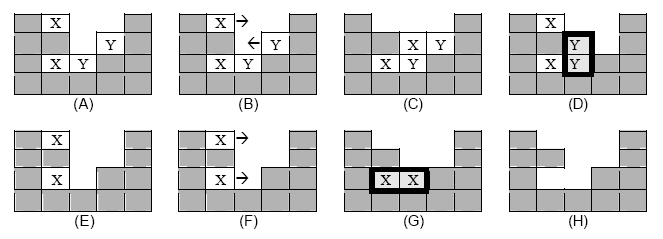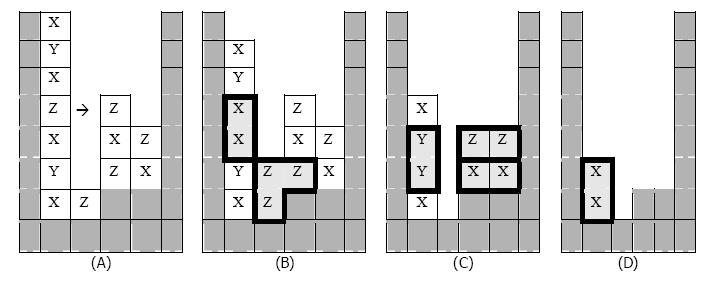354 . A Vexing Problem
Description
The game Vexed is a Tetris -like game created by James McCombe. The game consists of a board and blocks that are
arranged in stacks. If the space to the immediate left or right of a block is open (that is, it contains no other block nor
any part of the game board “wall”), then that block can be moved in that direction. Only blocks that are not part of
the game board wall can be moved; “wall” blocks are stationary in all events. After a block is moved, if it or any
other block no longer has anything under it, those blocks fall until they land on another block. After all blocks have
landed, if any two or more identically-marked pieces are in contact horizontally and/or vertically, then those blocks
are removed as a group. If multiple such groups result, then all groups are removed simultaneously. After all such
groups are removed, all blocks again fall to resting positions (again, wall blocks do not move). This might then
result in more groups being removed, more blocks falling, and so on, until a stable state is reached. The goal of the
game is to remove all the movable blocks from the board.
Consider the simple example shown here. For reference purposes, number the rows of the board from top to bottom
starting with an index value of zero, and number the columns from the left to right, also with a starting index value
of zero. Board positions can be therefore be referenced as ordered (row, column) pairs. By additionally using an “L”
or “R” to refer to a left or right push respectively, we can also use the ordered triple (row, column, direction) to
indicate moves.

In (A) we have two choices for moves as shown in (B). These moves are (0,1,R) and (1,3,L) using the identification
scheme defined above. Note that if we try (0,1,R), the resulting board state as shown in (C) is a dead end; no further
moves are possible and blocks still remain on the board. If we choose the other move, however, the blocks at (1,2)
and (2,2) are now in vertical contact, so they form a group that should be removed as shown by (D). The resulting
board state is shown in (E), leaving the two moves shown by (F). Note that either move would eventually allow a
solution, but (0,1,R) leads to a two move solution, whereas (2,1,R) leads to a three move solution. (G) and (H) show
the final steps if we choose (0,1,R).
There are often many ways to solve a particular Vexed puzzle. For this problem, only solutions with a minimum
number of moves are of interest. The minimum number of moves can sometimes be surprising. Consider another
example.

In this example there are ten possible first moves, and there are in fact several ways to arrive at a solution. There is
only one move in (A), however, that allows us to achieve a solution with the minimum number of moves. Observe
the sequence of events shown if (3,1,R) is chosen as the first move.
Input Format
The input will consist of several puzzles. Each begins with a line containing integers giving the number of rows
(NR) and columns (NC) in the puzzle, and a string of characters (terminated by the end of line) giving the name of
the puzzle; these items are separated by one or more spaces. This line is followed by an NR by NC array of
characters defining the puzzle itself; an end of line will follow the last character in each row. NR and NC will each
be no larger than 9. The “outer walls” (in addition to “inner wall” blocks) on the left, right, and bottom will always
be included as part of the puzzle input, and are represented as hash mark (#) characters. Moveable blocks are
represented by capital letters which indicate the marking on the block. To avoid possible ambiguities, open spaces in
the puzzle are represented in the input by a hyphen (–) rather than by spaces. Other than the outer walls, wall blocks
and moveable blocks may be arranged in any stable pattern. Every input puzzle is guaranteed to have a solution
requiring 11 or fewer moves.
A puzzle with zero dimensions marks the end of the input and should not be processed.
Output Format
For each input puzzle, display a minimum length solution formatted as shown in the sample output. In the event that
there are multiple solutions of minimum length, display one of them.
Sample Input 1
4 5 SAMPLE-01 #A--# ##-B# #AB## ##### 6 7 SAMPLE-02 #--Y--# #-ZX-X# #-##-## #-XZ--# ####YZ# ####### 0 0 END
Sample Output 1
SAMPLE-01: Minimum solution length = 2 (B,1,3,L) (A,0,1,R) SAMPLE-02: Minimum solution length = 9 (Y,0,3,R) (Z,4,5,L) (X,1,3,R) (Z,1,2,R) (Z,1,3,R) (X,3,4,R) (X,3,2,R) (X,4,5,L) (X,1,5,L)
Hints
Problem Source
Migrated from old NTUJ.
Subtasks
| No. | Testdata Range | Score |
|---|